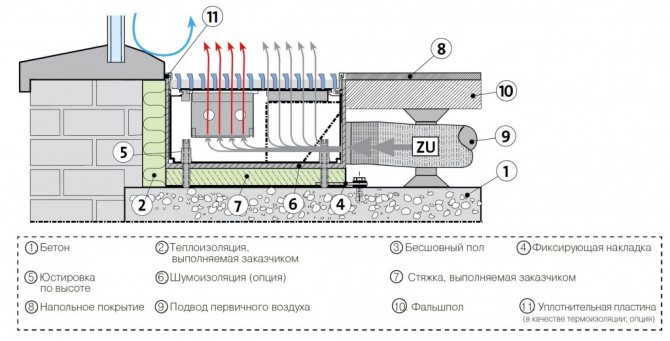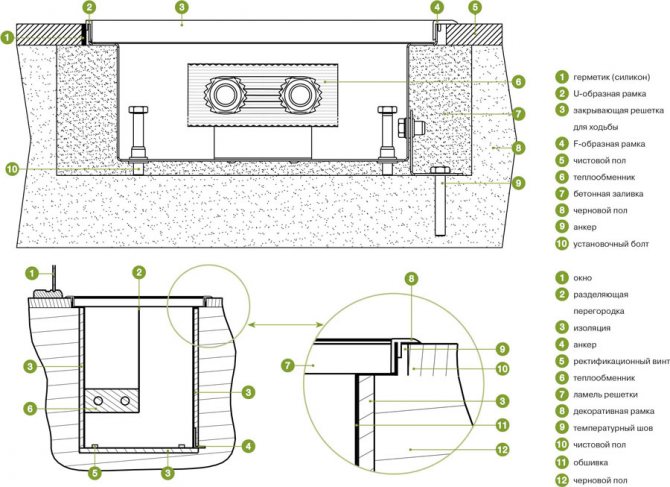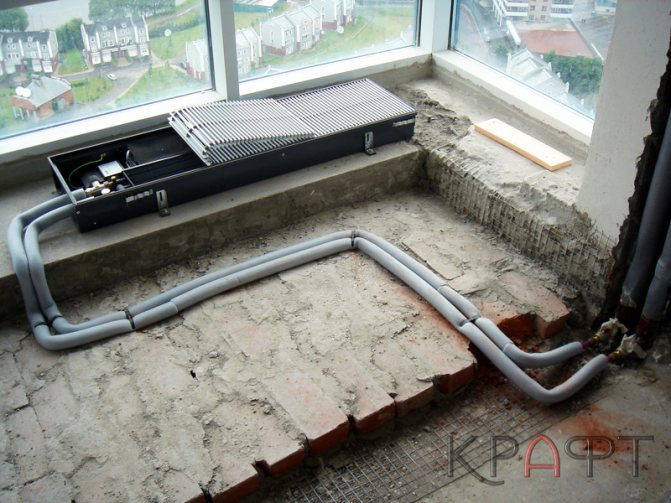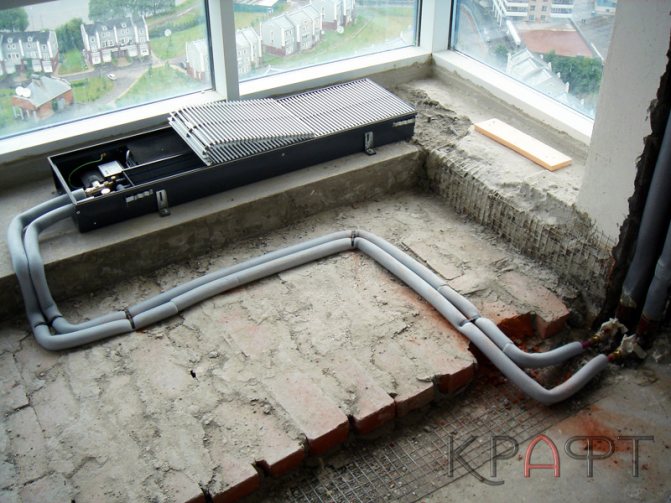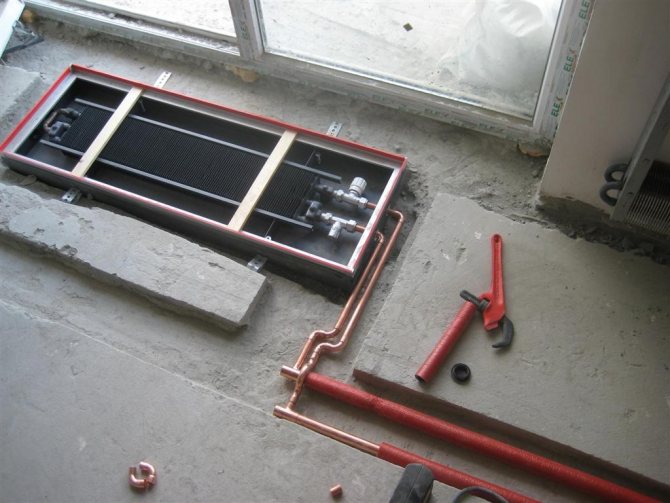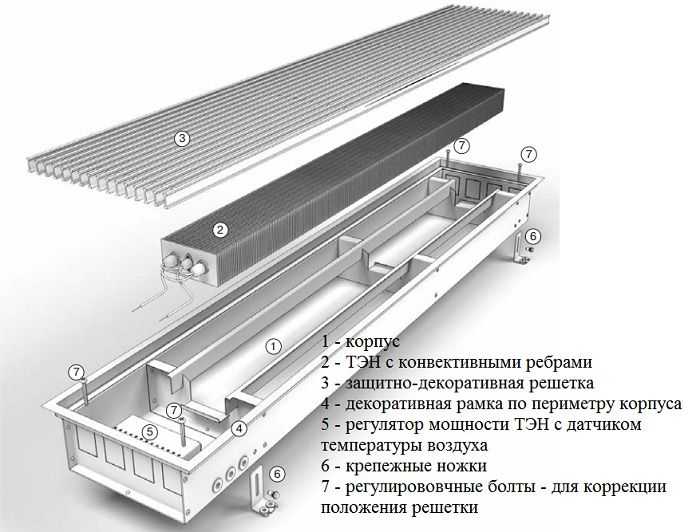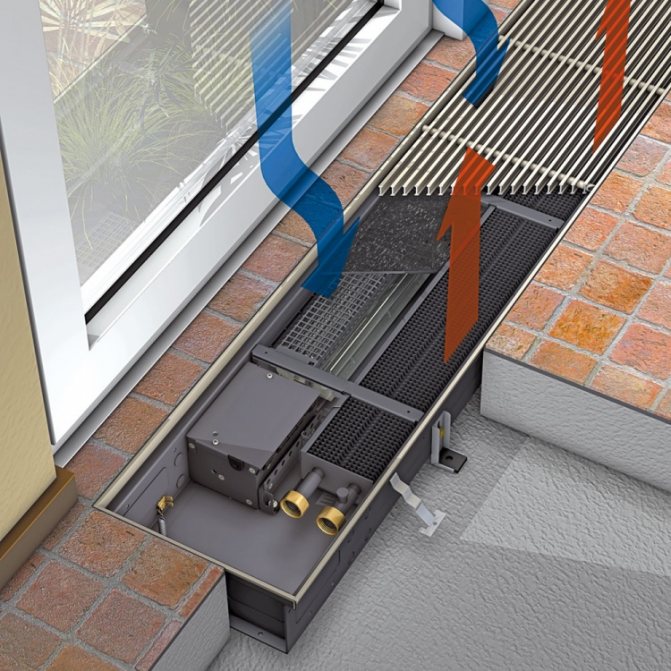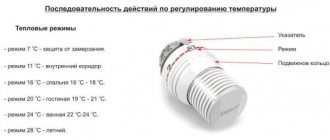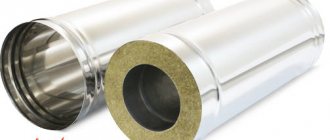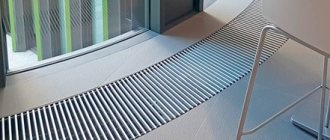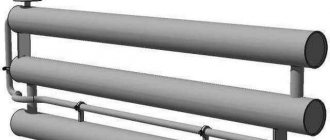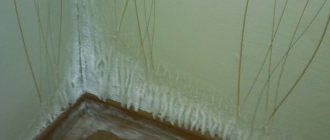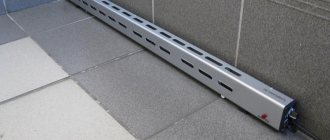Rating: 488 Heating convectors, like any other development for a heating system, show high efficiency when used. Do-it-yourself installation may vary depending on what is being used.
The carrier of heat can equally be both water in heating, and electricity or gas. The place of installation of heating convectors is highly dependent on the method of operation. preferably placed vertically. placed on the floor or suspended from the wall, the same is the case with a device that works on water. Further in the article we will talk about how the installation of heating convectors of various types is carried out.
Photo of a diagram of a water convector device
Copper and aluminum elements are usually the most expensive. But sometimes, when installing a convector system, it is precisely copper elements that are needed, they help to facilitate the heating system. However, or metal alloys are much more democratic in price and are used much more widely. But in this case, it is necessary to purchase expensive auxiliary elements. There is also a very affordable option - a steel heating system. in this case, it can be connected at the bottom or lateral.
Water-type equipment, first of all, requires preliminary hanging of the radiator on the wall. And before that, holes must be made in the wall for inserting holders that will support the heating battery. After drilling the holes and inserting the holders, the convectors are hung on them. Then, using nozzles, the devices are connected to the entire heating system.
The water radiator is best connected to the structure thanks to pipes made of steel or plastic, rather inexpensive materials.
However, if, while working with, it is possible to do the installation of the system yourself, then when you purchased it, it is better to consult a heating system installer.
Equipment that uses electricity is as efficient and convenient as water-based equipment. Do-it-yourself installation of electric heating convectors is a fairly simple matter, you can even do it yourself. You just need to follow the instructions, which are quite simple.
The procedure is as follows:
- The purchased unit must be properly unpacked.
- Then you need to remove the protective film with a gentle movement.
- It is, of course, important to find the most advantageous location for mounting the unit.
Electric convector device
Before proceeding directly with the installation of electric convectors, you need to familiarize yourself with the following nuances:
- The device must be suspended at a height of at least 0.2 m.
- Space is also required between the walls and the device, but not exceeding a quarter of a meter.
- Hanging too high is also not worth it. You need to leave at least half a meter of space and more.
- The equipment should not be in the immediate vicinity of power supplies. Observe a distance of 0.35 m or more.
The procedure for self-installation of an electric convector is as follows:
- First you need to turn the device over and build on it something like support legs that can be moved using the built-in wheels. To make something like this, you need bolts from the standard kit.
- In general, that's all. The device is ready for use, you can start working and customize it to suit your personal needs.
The installation of gas convectors for a heating system is not as simple as with previous types of heating equipment, and you cannot do it with your own hands. And it is not worth experimenting, since the system may not only not work, but also cause some harm.
Installation instructions
Experts know that before the main stage of the installation of gas convectors, it is necessary to carry out preparation.
For this you will need:
- Make support legs. They do not require any special material, so leftovers from used pipes can be used to construct them. They can be steel or aluminum, these are the most suitable metals.
- If the diameter of the air outlet is about 15 cm, then a larger hole must be drilled in the wall, about 23 cm.
- Next, a shielding surface is lined, for which basalt is best of all useful.
- The same shelter is erected on the back of the equipment.
- The unit itself is installed in a vertical plane and then attached to the gas source.
The installation of heating convectors can be associated with the use of some additional tools.
Required tools for installing convectors:
- Drill with the ability to replace drills with other, larger or smaller caliber;
- Various types of bolts;
- Tool for metal processing;
- A hammer;
- Steel sheets;
- Basalt sheets;
- Welding tool for plastic;
- Angle grinder;
- Hand saw;
- Solid pipes and cutoffs of different pipes.
Your contacts in this article from 500 rubles per month. Other mutually beneficial cooperation options are possible. Write to us at
Floor convectors are actively used to heat rooms where there are large heat losses due to large windows and doors. They are installed in special niches arranged in subfloors. The procedure is not very simple, but also not very complicated. Let's see how do-it-yourself installation of floor convectors is carried out. We will also consider some of the features of the care of these heating devices.
Appointment of floor convectors
Installation of floor convectors is justified if there are elements in the room that generate heat losses. These include:
- Floor-to-ceiling glass doors;
- Entrance areas to the loggia with windows and thin doors;
- Exits to the terraces;
- Panoramic windows (stained glass).
The decorative grill is the only thing that gives out the floor convection heater.
With a sufficiently small ratio between the area of the windows and the area of the floor, significant heat losses occur. In addition, an unpleasant cold blows from the giant glazing. The problem is partially solved by installing triple glass units, but they are distinguished by their high cost. Therefore, we can safely buy floor convectors and proceed to their installation with our own hands.
These heaters are compact, but require niches of suitable depth for their installation. Metal boxes (bodies) of convectors are installed here, after which they are fixed using special fasteners. From above, all this is closed with a decorative grill - this is just a brief instruction so that you have a general idea of the future do-it-yourself installation.
Floor convectors manufacturers, prices
There is a fairly wide selection of floor convectors on the Russian market. According to reviews, the following radiator models are especially popular:
Before installing heating pipes in a private house, you need to draw up a project, preferably backing it up with a hydraulic calculation.
You can find the rules for replacing heating pipes in an apartment building here.
The range of prices is quite significant. You can find heat exchangers for 6 thousand rubles. Prices for branded products reach 60 thousand rubles.Naturally, the quality of materials also depends on the cost. The grille can be anodized coating that does not wear off over time. In expensive models, a stiffer trough. This extends the service life and simplifies the installation of floor convectors.
The cost of the heat exchanger should also include additional costs for piping fittings. It is likely that fasteners will also be required - in cheap models, fasteners are not female enough. We wrote here about how to choose fittings for piping a radiator in a water heating system.
Selection of convectors
Installing an underfloor convector can seem like a rather complicated process. Therefore, we will describe everything step by step, starting with the choice of equipment. We can install electric or water heaters in front of panoramic windows or in front of the entrance area - it all depends on the type of main heating in the building.
Electric floor convectors operate on a 220 Volt network and are designed to heat households that are not connected to gas mains. In their design, most often, fans of one design or another (axial or tangential) are already provided. The disadvantage of electrical appliances is their high energy consumption, but in some situations they are irreplaceable. But only wires are needed to connect them.
Electric convectors can also be used in gasified buildings, where it is difficult to lay water heating to the place of their installation.
Installation of a water convector installed in the floor.
Water convectors have a similar design - there are heat exchangers that are connected to the heating system. For this, metal or plastic tubes are used, which require a certain skill for their laying. In this regard, electric floor convectors benefit - for their installation and connection, only wires of a suitable cross section are needed.
When planning the installation of a floor convector, pay attention to the choice of a model with forced convection. These devices have the following advantages:
- Higher heating rate;
- Increased efficiency of work in rooms with a ceiling height of 3 meters;
- Effective removal of moisture from the entire glazing surface.
By choosing floor convectors with low-noise fans, you can increase heating efficiency and prevent a source of noise.
Types of floor radiators
Immediately, we note that the installation of floor convectors in a screed does not in any way depend on its type. In this case, the principle of operation of different heat exchangers is different. There are two main differences - the air circulation method:
- natural;
- forced.

Convector design with natural circulation.
Natural circulation radiators are a copper collector of two tubes with aluminum fins, which is housed in a metal trough. In such batteries, the air moves due to the temperature difference. As you know, hot streams are lighter than cold ones, so they rise up.
In convectors with forced circulation, the air moves due to the operation of the built-in tangential fan. It looks like a wheel with curved blades. It works quietly, but still some noise is present. Floor convectors with a fan are connected to the mains, a control unit with a thermostat is installed in them.
The battery can be heated by a liquid heat carrier or by means of a heating element inserted into the collector tubes. Separately, it is worth highlighting the universal floor convectors. In the photo above, you can see that outwardly they do not differ from ordinary ones, the difference lies in the design of the collector.These heat exchangers can work both in a two-pipe heating system and in a four-pipe system, which we will talk about a little later.
Installation process
Dimensions of the floor convection heater and niche for it.
If you want to do the installation of the floor convector with your own hands, we recommend that you think over the place for its installation even at the stage of building the building - this will make it easier to organize a niche of a suitable depth. Moreover the niche itself should be 1-1.5 cm larger (on each side) than the metal box of the device
... At the same time, it is necessary to ensure that the upper part, where the decorative grille will be located, is on the same level with the future floor covering.
After the niche is ready, you can start installing the equipment. We fix the box for the floor convector using the supplied fasteners. We check the correctness of installation using a building level - the heater should be located in the niche evenly, without distortions. Further installation involves connecting to the heating system or the electrical network - for this, plastic pipes, flexible hoses or metal pipes of a suitable diameter are used.
If you are installing a water convector, consider thin, shallow recesses for piping / hoses. When installing the appliance, we recommend laying the connecting wires in cable ducts or pipes so that they can be replaced without problems. We recommend that the supply pipes with the heating agent be wrapped in thermal insulation.
The radiator pipes will also be screed.
At the next stage, we fill in the concrete screed - our do-it-yourself installation of the floor convector is nearing completion. The result of this stage should be a rough floor, with a metal box slightly protruding from it. Next, we make the final leveling of the floor, proceed to laying the floor covering. At the last stage, we place a decorative lattice above the box - it is best to choose it in the same tone as the color of the floors.
Do-it-yourself installation of floor convectors is complicated by the fact that you need to correctly select the size of the niche - so that the metal case of the device is located at the correct depth. You can find recommendations on this issue in the technical data sheets. Worst of all, if you have to carry out installation in an already finished house, it is not a fact that it will be possible to hollow out a niche in the subfloor, as this can affect its strength. In this case, it will be necessary to increase the height of the subfloor in all rooms.
Caring for the installed floor convectors is very simple - just remove the decorative grille and remove the accumulated dust inside. Do not use aggressive detergents for this.
Ecology of consumption. Manor: Among the various methods of heating a house, convector rightfully takes not the last place. Its main advantages are that when using this method, it is not necessary to create a complex heating system project, and also pipes and expensive water heating boilers are not required.
Among the various ways to heat a house, convector rightfully takes not the last place. Its main advantages are that when using this method, it is not necessary to create a complex heating system project, and also pipes and expensive water heating boilers are not required.
Let's try to figure out what convector heating is. As the name implies, this is a method of heating a room, which is based on air convection through the room itself.
It follows from the laws of physics that when heated, warm air rises, and cold air goes down.
Thus, there is a natural circulation of air and a gradual heating of the room. It is this type of heating that is a fairly simple, but at the same time effective way of heating.
Installation
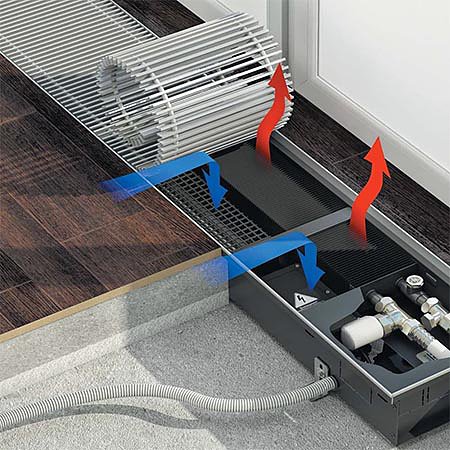

It is advisable to provide a place for installing a convector built into the floor at the stage of building construction. In this case, organizing a niche for installing a heating device will not cause problems.
Installation work includes the preparation of the niche, fixing the box, installation and connection of the convector.
What should be a niche for a convector
The size of the seat must exceed the dimensions of the convector's metal box by 3-5 millimeters. The gap is needed so that it is possible to adjust the height of the convector with adjusting screws and fix it with a solution.
Note: Leave more space on the wire or tube side.
The depth should be such that the decorative grille is flush with the floor. The landing gap here is 10-15 millimeters. Therefore, the preparation of the niche begins after the selection of the floor convector.
The size of the gaps is very arbitrary and can deviate in a large direction in accordance with the technical conditions and features of the connection of the device.
In damp rooms and when installing air-conditioning convectors, a pipeline is required to provide drainage. In this case, the box is installed with a slope of 1-2 degrees towards the drainage hole.
Where should the fan be?
The direction of the warm air flow affects the heating efficiency. A fan installed close to the window allows you to quickly heat up the room. If installed at a distance, the heating device creates a heat curtain.
In cases where the floor convector is the only source of heat, it is necessary to place the heat exchanger on the side of the room and the fan closer to the window.
Forced convection heaters are generally used for space heating. Therefore, they are installed so that cold air from doors and windows naturally descends into the heat exchanger, and then goes into the room.
Indents from walls and windows


Manufacturers recommend placing convectors with an offset of 10-25 millimeters from the window. The distance to the wall should be within 10-20 millimeters. This ensures easy access to the heater for repair and maintenance of the device.
Heating connection
To supply the coolant, two types of connections for the coolant supply are used - rigid and flexible. Each of them has its own advantages:
- The flexible hose connection simplifies the cleaning of the convector. On models where the heat exchanger can be lifted, the movable joint allows the part to be lifted to remove dust and dirt from it.
- Rigid tubes are considered more reliable. Their use reduces the likelihood of leaks. However, the fixed connection prevents the heat exchanger from lifting, making cleaning difficult.
Electrical connection
Electric convectors are connected to the mains with wires, the cross-section of which is calculated in accordance with the current consumed by the heater.
Power supply is also necessary for water floor convectors equipped with fans. In this case, the supply voltage is 12 volts. Therefore, they are connected to a 220 volt network through a transformer module.
Water convectors with fans are equipped with a room thermostat that controls the servomotors and fans, maintaining the set temperature in the room.
Some manufacturers provide for the installation of the transformer module directly into the box. This solution simplifies installation work.
Decorative grilles


The material of the grates should be selected based on individual preferences and the overall design of the room. Only natural wood is used in the manufacture of wooden gratings. To protect it from external influences, the tree must be covered with wood stain and varnish.
Aluminum structures are more durable.They are protected from moisture and aggressive substances by anodizing.
The minimum load for gratings, regardless of the material of manufacture, is 40 kilograms per bar. However, the tree wears off faster. Therefore, it is undesirable to lay wooden grilles in doorways.
What is a convector
The convector is a heater housed in a steel casing. The air passing through the elements (ribs) of the heater gradually rises upward. And from below, since the heater is located in the housing, cold air is suitable.
Thanks to this design, circulation occurs. Above the body has a grill for heated air outlet. In some cases, it is equipped with louvers to regulate the air flow.
Floor convector components
What are convectors
By the principle of working with energy carriers, there is a wide selection of such equipment. But now most of the convectors sold in stores have an electric heater. There are models that run on gas - gas convectors.
Electric convectors are best suited for heating apartments because of their compact size. It is more profitable to operate convector heating of a summer cottage or a country house, creating it on the basis of gas convectors - gas is much cheaper. Of course, subject to the availability of gas in the house.
According to the method of installation, convectors can be divided into:
- Outdoor;
- Wall-mounted;
- Floor or skirting board.
- Floor convectors are installed on the floor, they can have wheels for moving on the floor surface, or they can be rigidly installed, without the possibility of movement. Photo with a floor convector below.
- Wall-mounted convectors for heating are mounted directly on the wall using special brackets.
- The third type of convectors can be installed in the floor or in the baseboard.
Convector device
The convector has three main units. It:
- Housing;
- A heating element;
- Control unit (thermostat);
Housing
- The body of modern convectors is made of steel. With the widest selection of equipment on the market today, you can easily find a cabinet design that suits your space.
- Wall-mounted convectors, in addition, have special brackets (mounts) on the body, which allow you to remove the convector from the wall for cleaning wall surfaces and equipment.
- Modern convectors on the body can have louvers set at a certain angle to direct the air flow. Very often these blinds are not installed on top of the cabinet, but on the side.
- Due to this arrangement, the air flow from the convector is more extensively distributed throughout the room and contributes to its better and more uniform heating.
Advice. Choose a convector with a small power reserve (10-20%) if a corner room will be heated. Since the room will be underheated.
A heating element
- Considering electric convectors, we can say that heaters are installed in them of various types. The most inexpensive convectors, for example, are equipped with spiral heaters. This type of device can be found in inexpensive models. Their price is about $ 30- $ 50.
The most ordinary electric convector
Due to the high heating temperature of the spiral (up to 160 C 0), they quickly warm up the premises. But this type of heating coil is very dangerous. Since dust intensively accumulates on it, and water can also get on the heating element, which ultimately can lead to a fire.
But due to their low cost, convectors with a spiral heating element are very popular. In addition, many firms, in addition, mount fans on the casing, which, together with the high-temperature spiral, makes the heating even more intense.
- In more expensive models, a safer type of spirals, a low-temperature type, is mounted (the heating temperature does not exceed 100 C 0).
The heater is an aluminum radiator-diffuser, a steel pipe is mounted in it, and a special heating thread is inserted into this tube.
The aluminum body of the heatsink contributes to more efficient heating. Some manufacturers install not one, but two heating pipes in such a radiator. Thus, allowing you to turn on the heating unit itself, both at full power and at half of its power.
It should be noted that due to the difference in expansion when heating aluminum and steel, there is a gradual destruction of the strong bond between the heating tube and the housing. Over time, the radiator housing can completely lose its connection to the heating pipe. This can lead to local overheating of the tube and failure of the heating element.
Currently, manufacturers of electric convectors are actively working on improvements and trying to eliminate this shortcoming.
The RX-Silence heater, developed and patented by NOIROT (France), has a currently unique design.
The uniqueness of the solution lies in the fact that a nichrome heating thread is located in a completely sealed silumin radiator casing, in a compacted filling of magnesia powder.
The materials used have similar expansion coefficients. This solution allows not only to reduce energy consumption, but also to extend the convector's service life up to 15-17 years.
Electric convector control
- The most primitive control unit used in convectors is a thermostat mounted in the convector body. The thermostat can be electromechanical or electronic.
The first type of control is the cheapest, and therefore the least accurate (the error can reach 2C 0) and noisier as the bimetallic sensor clicks, including the heater. Usually, the temperature in the electromechanical thermostat is set by turning the knob with the graduated conventional values of the convector power.
The electronic thermostat has a more accurate (error no more than 0.1 C 0) and quiet operation of the convector. In addition, many manufacturers allow the electronic control unit to be programmed to turn on the convector in different modes, at different powers at different times of the day and day of the week. Moreover, the electronic thermostat allows you to control the heating panel itself remotely, through a remote control and management unit.
This solution allows you to control a large (up to 60 pieces) number of convectors in different parts of the house with just one button. In the unit, you can set various built-in heating programs for each room separately or for the entire building.
- The market leaders of "smart" convectors are rightfully the French company NOIROT and the German giant Siemens. The control units in the convectors of these manufacturers allow you to control the temperature even remotely, via the telephone. This function will be useful when you need to warm up the room in advance.
Manufacturers of electric convectors today produce equipment with a capacity of 0.8 kW -3.0 kW. The mass can be from three to nine kilograms.
Produced modern electrical converters can be divided into types:
High convectors, due to their height, create a very active convection. A lower power heater is installed in skirting convectors. To maintain the efficiency of the equipment, it is made as long as possible (up to 2.5 m).
In addition to electric convectors, there are also gas convectors. Their principle of operation is the same as that of electric ones. Only the heaters work not due to the spiral, but due to the combustion of the gas.
The gas burns in a special chamber, the walls of the chamber heat up and give off heat to the radiator. He, in turn, is already heating the air.
Gas convector
Gas convectors do not have complex electronic control systems, but due to the use of gas, their operation is cheaper than electric ones. But the complexity of their installation and the requirements for the presence of a chimney do not allow them to be used in apartments.
There are many videos on the Internet that will serve as an example of installing a convector for you.
It is not so difficult to mount an electric convector with your own hands.
To work, you will need very few tools:
Mounting bracket
Installation instructions for a wall-mounted electric convector:
- We assemble the convector, attach the brackets to it;
- We apply the entire structure to the wall, set it according to the level;
- We mark the installation locations of the brackets;
- Disconnect the brackets from the panel;
- We apply brackets along the outlined boundaries;
- We mark the attachment points (drilling);
- Using a hammer drill, we drill holes at the marked points;
- Using a hammer, carefully drive the dowels into the wall;
- We fasten the brackets with a screwdriver or screwdriver;
- We mount the convector panel on them;
- We connect the equipment to the outlet.
Features of installation of floor convectors
Installation of a floor convector requires preliminary information preparation. Not every building architecture allows heating an apartment, house or office with floor convectors. In this matter, many parameters are important: the dimensions of the system, the structural features of the floor, the depth of installation, and others.
Installation of underfloor heating equipment cannot be called complicated, therefore it is most often carried out on its own without the involvement of specialists. This significantly reduces the cost of installing such equipment. Before starting installation, you should carefully study the instructions and regulations. This approach will eliminate many installation problems and extend the service life of the heater.
Location the convector in the room is determined taking into account some features: the area of the room, the presence of window openings, etc. The floor convector must be installed in a place that is safe and most appropriate for the heating system. It should be remembered that it is prohibited to install underfloor heating devices near ventilation openings, near curtains and blinds, next to a door or interior screen.
Before choosing a convector, you need to determine niche sizesin which it will be installed. Each underfloor heating device has its own dimensions and requires a certain place for full operation. The dimensions of the convector are measured according to the following parameters: height, width and depth. Only after making such measurements can you decide on the size of the niche. It is important to remember that the dimensions of the niche should be slightly larger than the dimensions of the convector itself. Then the air exchange will be optimal, and the device will be provided with suitable conditions for efficient operation. It is necessary to leave about 1-1.5 cm as a gap during installation. At the same time, the device should not protrude above the surface of the floor covering or be significantly below this level. Allowable discrepancies - no more than 1 mm.
To determine the width indicators for the formation of a heating device niche, it is necessary to measure the width of the device itself and add 3-5 cm as a gap. This is necessary in order to be able to produce fixing the device cement. In addition, this approach to installation allows you to adjust the height of the box using bolts and bring the floor covering in the most competent and practical way.
When determining the length of the installation niche, add 3-5 cm to the measurements of the length of the floor convector.This will simplify the connection of the device as much as possible.
When it comes to the installation of underfloor heating equipment in conditions high humidity, then it is worth taking care of the installation of the drainage pipeline. It is also worth paying attention to the need to install the convector at an angle (1-2 degrees will be quite enough). The slope should be directed towards the nozzle. This will completely remove moisture from the system.
The scope of delivery of underfloor heating equipment includes bolts and special legs that allow the device to be connected to the floor. Convector installation process is reduced to fixing the legs on the rough field and further adjusting the height of the device by means of bolts. Often, manufacturers provide almost identical wiring diagrams. To avoid inconsistencies, you should carefully study the instructions for a specific device before installing it.
The bottom and walls of the device box are not designed for mechanical stress. Before pouring insulating material, make sure that the spacer plates and strips are present. They perform a protective function and prevent debris and dirt from entering the inside of the box. After finishing the installation of the box, the strips and plates must be removed. If debris gets into the fan or heat exchanger, it will cause further damage to the device. In addition, dust and debris can significantly reduce the heat output of the convector.
When the installation of the floor convector is carried out under the window opening, then an indent of about 10-15 cm should be left. The presence of curtains and curtains can interfere with the movement of warm air; it is better to determine their location after the installation of heating equipment.
Hydraulic connection There are two types of heating device to the system: flexible (with the help of flexible hoses, it makes it easier to clean the convector due to the possibility of lifting the heat exchanger) and rigid (more reliable connection, but complicating cleaning).
When the device has fan, then you should pay attention to the features of the electrical connection. This type of connection involves the additional purchase of a transformer or convector module. Such a device allows the convector to work productively, despite the fact that the voltage in the network is 220 V, and the fan, as a rule, has 12-24 V.
Distance from the fan of the underfloor heating device to the window is determined depending on the purpose of the convector. When a floor convector is purchased in order to create a heat curtain against cold air from outside, the fan should be located closer to the room. It is worth directing the flow of heated air towards the window. When the convector is required to heat the room, it is better to place the fan closer to the window. This will direct warm air into the room.
The choice of the convector grille completely depends on the taste preferences of the owner of the room and his requirements for the heating system. The most wear-resistant are aluminum grilles. Wooden decorative grilles are made of natural wood and have a very attractive appearance.
In order to hide the joints and give the heater a more harmonious look, a special decorative frame should be used.
Outcomes
Convection heating is a very good option for space heating. Convectors can be recommended for installation both in small apartments and in large country houses. They have good performance and efficiency. published
Using water as a heating medium is a cost-effective idea. Increasingly, instead of the usual batteries, water heating convectors are installed in apartments. Such advantages as: safety, compactness, exclusive design only contribute to the growing popularity of convectors.
Principle of operation in 2 and 4-pipe systems
Installation of floor convectors can be carried out in two-pipe and four-pipe circuits. In the first case, the heat exchanger works only for heating the room, and in the second - for heating and cooling. With heating, everything is simple, in this case the convector is connected and works in the same way as any other battery. When buying, you need to pay attention to the characteristics, they indicate the possibility of working with antifreezes. In two-pipe heating systems, water or propylene glycol (antifreeze liquid) can be used as the heating medium.
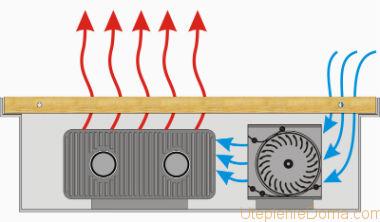

The principle of operation of a convector with forced ventilation.
In order for the floor convector to work in two modes (heating and cooling), it must be connected to:
- water heating system;
- fan coil.
A fan coil unit is a unit that produces cold according to the principle of an air conditioner. In this case, the heat exchanger built into the floor will act as a chiller. The difference between the chiller-fan coil tandem and split systems is that not freon, but water is used as a working substance. This is what makes it possible to install the floor convector on two systems at once. Naturally, it can only work in one of the modes one by one.
Design features
Externally, the unit is a rectangular solid body, covered with a lattice. The floor-standing version looks like a small bench, the wall-mounted one is of a small thickness, and the built-in ones can be seen only thanks to the grate.
The classic casing is made of stainless steel. But, taking into account the design features of the premises and the wishes of customers, the body can be made of wood, marble chips or MDF panels.
Ascetic outside, inside the convector for hot water heating are more complicated. Their "heart" is a heat exchanger, which is a copper flat or a tube in the form of a coil. The lamellas are attached to it perpendicularly by the method of tight fit.
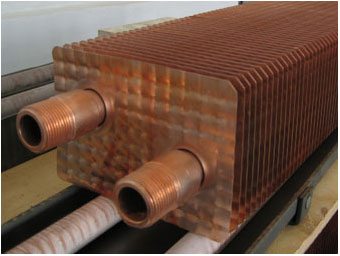

The place of their connection with the pipe should exclude the slightest gaps that reduce heat transfer. For the manufacture of plates, copper is most often used, there may be options from steel and aluminum, the main thing is that the thermal conductivity is at a height.
Note! Given the constant contact with water, this element must also be resistant to corrosion. So non-ferrous metals are preferred.
Connection to a riser or central pipeline is carried out through special threaded inlets inside, which are located at the end of the device or on the side. On modern heating water convectors, valve taps or manual / automatic valves are installed to release excess air that impairs heat transfer.
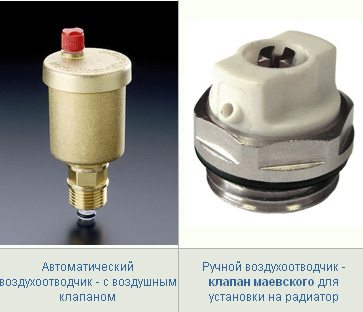

If an electronic thermostat / thermostat is included, it will control the working rhythm of the appliance. The heating process periodically stops when the set temperature is reached and starts again when the air cools down.
To enhance air circulation, a fan is used, which is either already built-in, or it will have to be purchased. This useful addition (1-2 pieces) is found only in.
How convection helps you keep warm
Unlike conventional batteries, which heat the air by emitting heat from their surfaces, hot water convectors operate in a different way. They mix air masses, replacing warm air with cold air and creating a pleasant atmosphere. At the same time, there is no dryness and a specific unpleasant smell of burnt dust.
The heat exchanger receives hot water from the heating system and heats the plates. Considering the thermal conductivity of the material used, as mentioned above, the parts heat up very quickly. Through the holes in the grate, warm masses rise unhindered, displaced by cold ones.
The built-in fan stimulates this process, and in a few minutes you can already feel the result.At the same time, the efficiency increases to 95%, which makes it appropriate to use water convectors in spacious rooms with large window and door openings.
In accordance with the requirements of GOST 20849-94, water heating convectors must have the first inherent property - tightness and strength, which is checked with a test water pressure of 1.5 MPa. Heating elements and the casing must be coated with an anti-corrosion heat-resistant compound.
Among other things, a water heating convector is relatively inexpensive, given its growing popularity. Installation by specialists of a wall, floor or baseboard structure will cost you almost half the price of a trench. This price is justified by the complexity of the preliminary work on the installation of a niche in the raised floor.
Brief description of typical convectors
Of great importance for water heaters are their technical characteristics, it is on their basis that a specific heater model is selected.
The characteristics of most typical convectors are within the following limits:
- the maximum allowable pressure during operation is 16 bar;
- pressure testing - 25 atm;
- the water temperature can reach 130 ° C;
- maximum case heating - 60 ° C;
- the heat exchanger can be 4 or 6 rows;
- the volume of water in the heat exchanger is 0.7–0.9 l;
- throughput per hour from 90 to 170 liters;
- power from 100 to 200 kW;
- the weight ranges from 14 to 21 kg.
Installation work
Installation instructions for water heaters are simple and consist in connection to the heating pipeline. Floor models are installed at the same time as the floor, wall or skirting models can be installed at any time.
The installation process includes the wiring of electrical cables, coolant supply circuits, a niche for the unit box, which must be flush with the finished floor. It is better to entrust this work to qualified specialists.
Note! Also entrust the calculation of the power of the installation to a specialist, if you are not a heating engineer, you may not take into account, for example, heat loss when calculating heating. You will need information about the area of the room, its thermal insulation and the height of the ceilings.
Depending on the purpose, the heating water convector can perform 2 functions:
- heat the room - the device is installed away from window openings;
- create an air dam for cold air in the window area - a heater opposite the window at a distance of 20 to 30 cm.
Perfect heating is achieved by observing the prerequisites for installation:
- The supply / removal of heat carriers is made of rigid or flexible connections and shut-off valves
(included).
- The convector niche must be so deep that the decorative cover of the appliance is flush with the finished floor.
- Permissible gaps for the width and height of the convector are from 10 to 15 mm
. - The hot water convector is horizontally aligned and fixed with the adjusting bolts.
. - The gaps are insulated and sealed with a special material
. - After installing the finished floor, connect the connections
(electric is required if there is a built-in fan). - Seal the remaining gaps with sealant / finishing material, switch on the appliance and cover with a grill
.
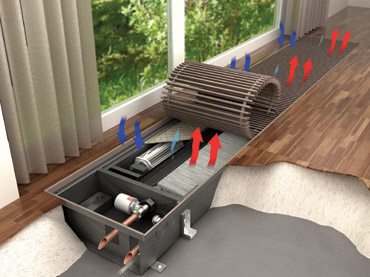

Installation of wall and baseboard heaters does not have so many nuances and consists in connecting the object to the water supply network, and this is easy to do with your own hands.
Before working with a wall heater, you need to remove the battery, then proceed directly to the installation.
- Instead of radiator plugs, screw on the sleeves two couplings with the same diameter of the connection - usually 20 mm.
- Fix the convector on the brackets and align its thread axes with the squeegee axes.
- Wind up the threads on the heater, drive the couplings on them to the stop and tighten the locknuts.
- To avoid water hammer, when starting up the riser, open the valves slowly.
Note! When connecting the baseboard model to the city heating network, use multilayer plastic XLPE pipes with special fittings. The second option is soldering. This will protect your design from tricks with changes in water temperature and pressure surges.
Features of caring for the floor convector in the apartment
Maintenance of the underfloor heating convector is relatively simple. The basic instructions for cleaning the internal elements of the structure are necessarily included with the product. Among the additional requirements for operation, there is one important point: the temperature that the manufacturer has declared is optimal for a particular product must not be exceeded.


Routine cleaning is recommended at least once every two weeks. To remove all dust accumulated inside, you must first remove the decorative grill, and then thoroughly vacuum the inside of the product using a special nozzle. If there is a flexible pipe in the structure, the heat exchanger can be lifted, which means there is access to the inside of the housing itself.
If you are still in doubt about the choice and installation of an underfloor heating system, evaluate its advantages and disadvantages in relation to a particular room in comparison with alternative radiators.
Summarizing
The use of water convectors is the cheapest form of heating. a variety of installation installations allows you to unobtrusively warm up the room without overdrying the air. Temperature control systems allow you to maintain a constant thermal threshold, saving the family budget.
The video in this article will demonstrate in detail and in an accessible manner the installation process of a water floor convector.
Gas convectors are significantly inferior in popularity to similar electrical equipment. First of all, because the installation of this equipment requires a centralized gas supply, or at least gas in cylinders. In addition, electrical equipment is safer. However, the operation of gas devices is cheaper, therefore a gas-type convector is an excellent solution for a country or country house, to maintain a normal indoor climate. The topic of today's article: do-it-yourself gas convector - its installation and use.
Installation and strapping of batteries in the floor
The difficulty of installing a floor convector with your own hands is that its grate is flush with the floor covering. Therefore, it is extremely important to precisely align the heat exchanger trough according to the water level. At the same time, it is necessary that it stand firmly, because they will walk on the lattice. Installation is carried out in a cut-out niche, a screed is poured around the perimeter. Fill nuances:
- stick a damper tape around the perimeter of the case;
- do not remove the grate until the solution has completely solidified.


The convector grille must be flush with the floor.
The damper tape compensates for the thermal expansion of the screed and dampens possible vibrations from the fan operation. It is imperative that the grille is inserted into its seat. During solidification, the screed can deform the trough and the lattice will no longer be there at all.
The housing has holes for several connection options, which depends mainly on the position of the radiator in relation to the circuit. In principle, the simplest piping option is to install conventional ball valves for the supply and return. Ideally, faucet handles should point downwards so that they cannot be seen through the grate. Also, in some convectors there is not enough trough height to install the shut-off valves with the handles up.
If the electrodes for welding heating pipes are damp, then they cannot be used, at least until they are dry.
Here we compared pipes for heating a private house.
The above piping method is not suitable if you have a long heating system with several branches of different lengths. In this case, for the correct operation of the circuit, balancing is required, and for this, there must be a balancing valve on the radiator return. In addition, ball valves do not make it possible to regulate the degree of heating of the battery, which is very useful. Therefore, a thermostatic valve must be installed on the supply, preferably in tandem with a thermal head or a servo drive.
General device
The components of the gas convector are:
- A heat exchanger that heats the air in the room.
- The programmer is a device for maintaining and controlling the air temperature.
- Control panel with indicators.
- Gas valve to control the gas supply.
- Fan - to supply air to the heat exchanger and valve.
- Fan - for forced supply of heated air into the room.
Important! The principle of operation is quite simple. The device is based on the physical phenomenon of convection. The heated air rises upwards, and the cooled air falls downwards. The devices can operate both on the principle of natural and forced convection (in this case, the device is equipped with a special fan).
Benefits
The positive aspects of such a heater include:
- Economy, fast heating of the room.
- Ease of installation, the ability to install a gas convector with your own hands.
- No need for water heating.
- Acceptable cost.
- Unlike an electric appliance, a gas appliance does not burn oxygen.
- Autonomous mode of operation.
- There is no connection to the mains.
- Possibility of connecting the device to a gas cylinder.
Installation and strapping of batteries in the floor
The difficulty of installing a floor convector with your own hands is that its grate is flush with the floor covering. Therefore, it is extremely important to precisely align the heat exchanger trough according to the water level. At the same time, it is necessary that it stand firmly, because they will walk on the lattice. Installation is carried out in a cut-out niche, a screed is poured around the perimeter. Fill nuances:
- stick a damper tape around the perimeter of the case;
- do not remove the grate until the solution has completely solidified.
The convector grille must be flush with the floor.
The damper tape compensates for the thermal expansion of the screed and dampens possible vibrations from the fan operation. It is imperative that the grille is inserted into its seat. During solidification, the screed can deform the trough and the lattice will no longer be there at all.
The housing has holes for several connection options, which depends mainly on the position of the radiator in relation to the circuit. In principle, the simplest piping option is to install conventional ball valves for the supply and return. Ideally, faucet handles should point downwards so that they cannot be seen through the grate. Also, in some convectors there is not enough trough height to install the shut-off valves with the handles up.
If the electrodes for welding heating pipes are damp, then they cannot be used, at least until they are dry.
Here we compared pipes for heating a private house.
The above piping method is not suitable if you have a long heating system with several branches of different lengths. In this case, for the correct operation of the circuit, balancing is required, and for this, there must be a balancing valve on the radiator return. In addition, ball valves do not make it possible to regulate the degree of heating of the battery, which is very useful. Therefore, a thermostatic valve must be installed on the supply, preferably in tandem with a thermal head or a servo drive.
Classification
Gas convectors are mainly divided according to two characteristics: power and design. With power more or less clear. You need to choose the device that can heat the room.
Depending on the version, such heaters are distinguished:
- Floor standing - installed on the floor. No special skills are required to mount the floor unit. The appliance can heat fairly large rooms.
Important! Among the shortcomings, one can note a significant mass and the need for a foundation.
- Wall mounted. This is a more compact option. The device fits perfectly into the home interior. Most often, it is mounted above a window to create a thermal curtain from cold air. The power of the devices is low. They are suitable for use in homes up to 100 "squares".
Important! In addition to floor-standing and wall-mounted devices, there are also built-in ones. They have a beautiful design, and not only do not spoil, but also decorate the interior. In terms of their parameters, the convectors do not differ from the wall-mounted version. The downside is the complexity of installation (you need to prepare a niche in advance for installing a gas convector with your own hands.
When choosing a convector, be sure to pay attention to the material from which the heat exchanger is made. It can be steel, copper or cast iron.
Important! The most common option is steel, but a cast iron heat exchanger is more efficient and more durable. The copper heat exchanger is efficient and durable, but the cost of the device is high.
Advantages and disadvantages of floor convectors
Nowadays it is fashionable to install panoramic windows. Most of the heat from the room leaves through the glass, in the same way cold gets into the room. That is why the batteries are mainly installed under the window - to create a thermal curtain. Only floor convectors are suitable for panoramic windows. The dimensions must be selected so that the heat exchanger covers the entire opening.
The main advantage is that they create a thermal curtain for panoramic windows and do not spoil the view.
The disadvantages include the convection heating method, an integral part of which is air circulation. In this case, all the dust collected in the battery trough is carried away. In fact, it is very harmful. Constant stay in a dusty room can cause the appearance of respiratory diseases, up to asthma. Therefore, do not forget to clean the heat exchanger and the more often the better. To do this, simply lift the protective mesh and remove all debris with a vacuum cleaner.
What do you need to install a convector with your own hands?
- Drill and drills for her.
- Pipe cutter.
- Adjustable wrench, wrenches.
- Perforator.
- Scapula.
- Gas cock.
- Silicone (high temperature, sanitary).
- Screwdriver.
- Self-tapping screws, dowels.
Important! First, you need to choose the place where the convector will be located. Do not be lazy to study GOST, according to which the heater will be located under the window. All surfaces and furniture must be covered with textiles, since the work is quite “dusty”.
How to make a convector with your own hands: installation algorithm:
- Decide on the location of the hole for the gas pipe.
- Drill a hole through the wall according to the diameter of the chimney. The hammer drill is perfect for this.
Important! This is the most time consuming stage of the work. The hole will have to be punched out large enough, and more dust will appear than we would like.
- Drill holes for fixing the heater, drive dowels into them.
- Connect a chimney to the convector, seal the joint with silicone.
- Fix the heater to the wall with self-tapping screws.
Important! At this stage, you cannot do without an assistant, since the device is quite heavy.

